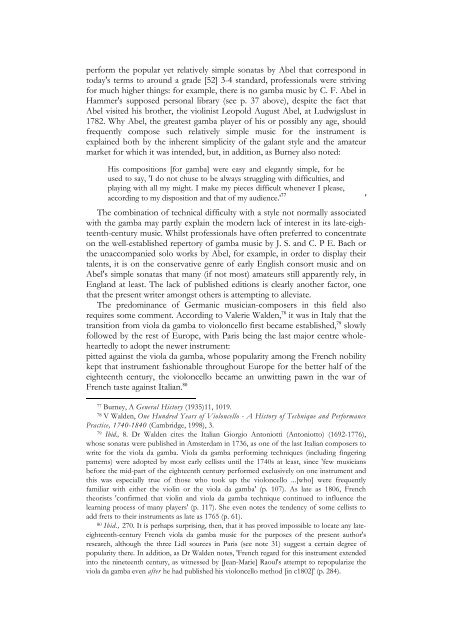download.pdf - 1.2Mb - Viola da Gamba Society
download.pdf - 1.2Mb - Viola da Gamba Society
download.pdf - 1.2Mb - Viola da Gamba Society
Create successful ePaper yourself
Turn your PDF publications into a flip-book with our unique Google optimized e-Paper software.
perform the popular yet relatively simple sonatas by Abel that correspond in<br />
to<strong>da</strong>y's terms to around a grade [52] 3-4 stan<strong>da</strong>rd, professionals were striving<br />
for much higher things: for example, there is no gamba music by C. F. Abel in<br />
Hammer's supposed personal library (see p. 37 above), despite the fact that<br />
Abel visited his brother, the violinist Leopold August Abel, at Ludwigslust in<br />
1782. Why Abel, the greatest gamba player of his or possibly any age, should<br />
frequently compose such relatively simple music for the instrument is<br />
explained both by the inherent simplicity of the galant style and the amateur<br />
market for which it was intended, but, in addition, as Burney also noted:<br />
His compositions [for gamba] were easy and elegantly simple, for he<br />
used to say, 'I do not chuse to be always struggling with difficulties, and<br />
playing with all my might. I make my pieces difficult whenever I please,<br />
according to my disposition and that of my audience.' 77<br />
'<br />
The combination of technical difficulty with a style not normally associated<br />
with the gamba may partly explain the modern lack of interest in its late-eighteenth-century<br />
music. Whilst professionals have often preferred to concentrate<br />
on the well-established repertory of gamba music by J. S. and C. P E. Bach or<br />
the unaccompanied solo works by Abel, for example, in order to display their<br />
talents, it is on the conservative genre of early English consort music and on<br />
Abel's simple sonatas that many (if not most) amateurs still apparently rely, in<br />
England at least. The lack of published editions is clearly another factor, one<br />
that the present writer amongst others is attempting to alleviate.<br />
The predominance of Germanic musician-composers in this field also<br />
requires some comment. According to Valerie Walden, 78 it was in Italy that the<br />
transition from viola <strong>da</strong> gamba to violoncello first became established, 79 slowly<br />
followed by the rest of Europe, with Paris being the last major centre wholeheartedly<br />
to adopt the newer instrument:<br />
pitted against the viola <strong>da</strong> gamba, whose popularity among the French nobility<br />
kept that instrument fashionable throughout Europe for the better half of the<br />
eighteenth century, the violoncello became an unwitting pawn in the war of<br />
French taste against Italian. 80<br />
77 Burney, A General History (1935)11, 1019.<br />
78 V Walden, One Hundred Years of Violoncello - A History of Technique and Performance<br />
Practice, 1740-1840 (Cambridge, 1998), 3.<br />
79 Ibid., 8. Dr Walden cites the Italian Giorgio Antoniotti (Antoniotto) (1692-1776),<br />
whose sonatas were published in Amster<strong>da</strong>m in 1736, as one of the last Italian composers to<br />
write for the viola <strong>da</strong> gamba. <strong>Viola</strong> <strong>da</strong> gamba performing techniques (including fingering<br />
patterns) were adopted by most early cellists until the 1740s at least, since 'few musicians<br />
before the mid-part of the eighteenth century performed exclusively on one instrument and<br />
this was especially true of those who took up the violoncello ...[who] were frequently<br />
familiar with either the violin or the viola <strong>da</strong> gamba' (p. 107). As late as 1806, French<br />
theorists 'confirmed that violin and viola <strong>da</strong> gamba technique continued to influence the<br />
learning process of many players' (p. 117). She even notes the tendency of some cellists to<br />
add frets to their instruments as late as 1765 (p. 61).<br />
80 Ibid., 270. It is perhaps surprising, then, that it has proved impossible to locate any lateeighteenth-century<br />
French viola <strong>da</strong> gamba music for the purposes of the present author's<br />
research, although the three Lidl sources in Paris (see note 31) suggest a certain degree of<br />
popularity there. In addition, as Dr Walden notes, 'French regard for this instrument extended<br />
into the nineteenth century, as witnessed by [Jean-Marie] Raoul's attempt to repopularize the<br />
viola <strong>da</strong> gamba even after he had published his violoncello method [in c1802]' (p. 284).
















